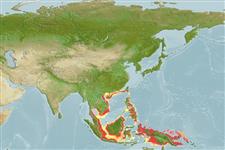>
Eupercaria/misc (Various families in series Eupercaria) >
Lethrinidae (Emperors or scavengers) > Monotaxinae
Etymology: Gymnocranius: Greek, gymnos = naked + Greek, kranion = skull (Ref. 45335).
More on author: Bleeker.
Environment: milieu / climate zone / rango de profundidad / distribution range
Ecología
marino asociado a arrecife; no migratorio; rango de profundidad 20 - 80 m (Ref. 2295). Tropical; 23°N - 10°S, 95°E - 157°E
Western Pacific: Indo-Malaysian Archipelago and South China Sea.
Tamaño / Peso / Age
Madurez: Lm ? range ? - ? cm
Max length : 35.0 cm TL macho / no sexado; (Ref. 2295); common length : 30.0 cm TL macho / no sexado; (Ref. 2295)
Espinas dorsales (total) : 10; Radios blandos dorsales (total) : 10; Espinas anales: 3; Radios blandos anales: 10.
Body shape (shape guide): fusiform / normal; Cross section: oval.
Occurs over sand, mud, and rubble areas. Feed mainly on small bottom-living gastropods. Marketed fresh or dried-salted. Also caught with bottom longlines and handlines (Ref. 9775).
Life cycle and mating behavior
Madurez | Reproducción | Puesta | Huevos | Fecundidad | Larva
Carpenter, K.E. and G.R. Allen, 1989. FAO Species Catalogue. Vol. 9. Emperor fishes and large-eye breams of the world (family Lethrinidae). An annotated and illustrated catalogue of lethrinid species known to date. FAO Fish. Synop. 125(9):118 p. Rome: FAO. (Ref. 2295)
IUCN Red List Status (Ref. 130435: Version 2025-1)
Threat to humans
Harmless
Human uses
Pesquerías: comercial
Herramientas
Special reports
Download XML
Fuentes de Internet
Estimates based on models
Preferred temperature (Referencia
123201): 24.2 - 28.7, mean 28 °C (based on 348 cells).
Phylogenetic diversity index (Referencia
82804): PD
50 = 0.5005 [Uniqueness, from 0.5 = low to 2.0 = high].
Bayesian length-weight: a=0.01698 (0.00734 - 0.03932), b=2.98 (2.79 - 3.17), in cm total length, based on LWR estimates for this (Sub)family-body shape (Ref.
93245).
Nivel trófico (Referencia
69278): 3.4 ±0.58 se; based on food items.
Resiliencia (Referencia
120179): Medio, población duplicada en un tiempo mínimo de 1.4-4.4 años (Preliminary K or Fecundity.).
Fishing Vulnerability (Ref.
59153): Low vulnerability (25 of 100).
🛈
